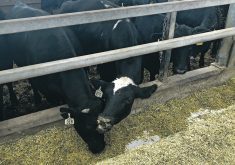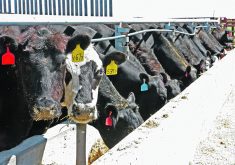Beef on dairy can improve meat’s marbling, yield, quality and carcass cutability without affecting milk production
Breeding beef animals to dairy cows is becoming more common, says Kee Jim, senior lead of animal agriculture at Telus and managing director for G.K. Farms.
He shared more information about beef on dairy with attendees at last month’s Canadian Beef Industry conference.
“In my 41 years of doing feedlot work and being involved with feedlot cattle, this is the most significant development I’ve seen in terms of the opportunity to create something that’s distinctly different than what we’ve done in the past,” he said.
Read Also

More work wanted on removing red tape
REGINA — Canadian farmers risk falling further behind competitors if two main federal agencies don’t become more efficient and responsive…
When sexed semen became widely used in the dairy industry in 2011, 90 per cent of all dairy calves were female, leaving a small per cent of Holstein bull calves for slaughter. A packer in the U.S. decided Holstein bull calves were no longer part of its program because beef cattle usually have better carcass characteristics than Holsteins. The market for Holstein bull calves collapsed.
“That obviously had a pretty major effect on the Holstein steer picture,” Jim said.
Crossbreeding Holsteins with beef breeds improves meat quality without affecting milk production. Jim said beef on dairy can improve marbling, yield and quality. It also improves carcass cutability, which makes it more desirable to packers.
“Some of the issues with Holstein steers, like shape and size of strips and ribeye, all of those issues go away,” Jim said. “And again, because of hybrid vigour, you also get improved animal health outcomes compared to the straight Holstein steer. So, there’s a lot of positive things about crossbreeding.”
Jim said the eating experience of beef-dairy crossbreds is likely better than that of beef cattle due to the age of animals when slaughtered.
“Tenderness is a function of age and slaughter, and most of these cattle are slaughtered under 18 months of age.”
Typically, calves are taken from dairy operations as newborns and bottle-fed for 40 to 50 days. Then they eat a full diet for about a year before slaughter.
“So they’ve been on a very high energy, dense diet, virtually for their 18 months … So, not surprisingly, it’s a very desirable eating experience, because you’ve got the high energy, long period of time and a youthful animal when it’s slaughtered.”
Jim said beef-on-dairy cattle also have a 40 to 50 per cent lower carbon footprint than beef cattle.
He sees benefits in this system for beef producers, specifically in the seedstock side of the industry. Dairy producers commonly use sexed semen and genetics are very important to them, so seedstock producers can use that to advantage.
“If you’re a seedstock producer in North America, you’ve got to be pretty happy with this deal, because now you have a customer that is going to be able to sell a large amount of semen. We’re not talking hundreds of thousands of doses here. We’re talking millions of doses.
“On the native cattle side, I don’t really see it as a threat.”


















